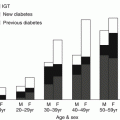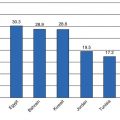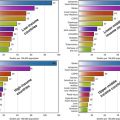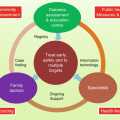Fig. 1.1
Global estimates and projections of the number of people with diabetes
In 2015, the International Diabetes Federation (IDF) estimated that globally, 415 million adults 20–79 years of age or 8.8 % of the adult population have diabetes [5]. There are 321 million people of working age (20–64 years) with diabetes and 94 million people aged 65–79 with diabetes. There are slightly more men than women with diabetes (215 million men vs. 200 million women). Currently, there are more people with diabetes in urban areas (270 million) than in rural areas (145 million). Age-adjusted diabetes prevalence rates among adults 20–79 years of age vary by region and by country. In 2015, the age-adjusted diabetes prevalence was 11.5 % in North America and the Caribbean, 10.7 % in the Middle East and North Africa, 9.6 % in South and Central America, 8.8 % in the Western Pacific and Southeast Asia, 7.3 % in Europe, and 3.8 % in Africa [5]. Perhaps most alarmingly, approximately 75 % of people with diabetes live in low- and middle-income countries [5].
Diabetes prevalence rates vary greatly among indigenous communities. These communities are characterized by unique languages, knowledge systems, and beliefs [5]. Many have a special relationship with their traditional land which often has a fundamental importance for their culture [5]. In many cases, the prevalence of diabetes is greater in indigenous populations than in the surrounding population such as in indigenous Australian [6], New Zealand Māori [7], Greenland Inuit [8], Canadian Inuit [9], and Native American populations [10]. Some indigenous populations that still live very traditional lifestyles have a relatively low prevalence of diabetes [5].
Not every person with diabetes has been diagnosed. Globally, it is estimated that one-in-two adults with diabetes is undiagnosed [5]. In regions where healthcare resources are lacking such as in sub-Saharan Africa, the proportion of people with diabetes who are undiagnosed is as high as 67 % [5]. Even in high-income regions such as North America, slightly more than one-third of people with diabetes have not been diagnosed [5]. Globally, 81 % of people with diabetes who are undiagnosed live in low- and middle-income countries [5].
The IDF has estimated that by 2040, 642 million adults 20–79 years of age or 10.4 % of the world population will have diabetes [5]. In 2040, proportionately more people with diabetes will be 65–79 years of age. The gender difference between men and women is expected to decrease modestly by 2040, but the global difference in the number of people with diabetes in urban and rural areas is expected to widen with 478 million people with diabetes living in urban areas and 164 million living in rural areas. The largest increases in diabetes prevalence will occur in regions where economies are moving from low-income to middle-income levels. By 2040, the IDF has estimated that the age-adjusted prevalence of diabetes will be 12.0 % in North America, 9.7 % in South and Central America, 9.0 % in the Western Pacific, 9.1 % in Southeast Asia, 7.6 % in Europe, and 4.2 % in Africa [5].
The global epidemic of type 2 diabetes has major implications for healthcare expenditures. Most countries dedicate between 5 % and 20 % of their total healthcare resources to treat diabetes and its complications [5]. In 2015, the IDF estimated that total diabetes healthcare expenditures for persons 20–79 years of age were $673 billion or 12 % of total healthcare expenditures worldwide [5]. The IDF has projected that this number will increase to $802 billion by 2040 assuming constant per capita healthcare expenditures [5]. The increase in healthcare expenditures for diabetes by 2040 is projected to be proportionately less than the increase in the number of people with diabetes because countries with the largest increases in the numbers of people with diabetes are those with the lowest per capita spending for diabetes. In 2015, an average of $1,622 was spent per person with diabetes [5]. The range in expenditures for diabetes varied by almost 85-fold: from $7,859 per person per year in North America and the Caribbean, $2,610 in Europe, $1,169 in South and Central America, $693 in the Western Pacific, $483 in the Middle East and North Africa, $243 in Africa, and $93 in Southeast Asia [5].
Not surprisingly, these dramatic differences in mean annual healthcare expenditures per person with diabetes are associated with major differences in the types of expenditures for diabetes. In developed countries where mean annual healthcare expenditures are high, a large absolute amount but a small proportion of total healthcare expenditures are for antihyperglycemic therapy [11]. The greatest proportion of healthcare expenditures for diabetes go for the treatment of complications and comorbidities. In contrast, in developing countries where mean annual healthcare expenditures are low, the greatest proportion of expenditures go for antihyperglycemic therapy [11]. Although some resources go to the treatment of acute metabolic and infectious complications, little is spent on the treatment of chronic complications and comorbidities such as renal and cardiovascular disease.
Economic development is associated with increased per capita healthcare expenditures. In a recent study, Seuring and colleagues examined the factors associated with the heterogeneity in diabetes healthcare expenditures among countries [12]. Their work demonstrated that the direct costs of diabetes are positively associated with a country’s per capita gross domestic product (GDP). Healthcare expenditures increase with national economic wealth. Per capita GDP explained about one-third of the variation in diabetes healthcare expenditures among countries such that every additional dollar in per capita GDP translated into an average increase in direct diabetes expenditures of about $0.04 [12].
This phenomenon is further illustrated by a study that assessed rates of end-stage renal disease (ESRD) treatment by national wealth [13]. In low- and middle-income countries with per capita GDP less than ~$10,000, rates of ESRD treatment were very low but tended to increase with per capita GDP. In contrast, in high-income countries with per capita GDP above ~$10,000, rates of ESRD treatment were consistently higher, reflecting greater access to ESRD treatment. Economic development thus appeared to be associated with increased demand for and access to expensive but lifesaving care. As low- and middle-income countries develop economically, the demand for and per capita expenditures for the treatment of diabetes and its complications will increase substantially. The future costs of healthcare for diabetes are likely to be many times higher than projected by the IDF and, if costs remain unchecked, have the potential to bankrupt healthcare systems and indeed national economies.
What can be done? All countries, but especially low- and middle-income countries with limited resources, must carefully balance the benefits and costs of allocating scarce healthcare resources for population-level and targeted interventions for diabetes prevention, for antihyperglycemic and cardiovascular therapies to delay or prevent the development of complications among people with diabetes, and for the treatment of advanced diabetic complications. Addressing only the healthcare needs of individuals with diagnosed diabetes will leave the epidemic of type 2 diabetes and its downstream complications, comorbidities, and costs unchecked. Clearly, tailored strategies that allocate resources to prevent diabetes, to treat diabetes, and to treat its complications and comorbidities will be required.
Stay updated, free articles. Join our Telegram channel

Full access? Get Clinical Tree








